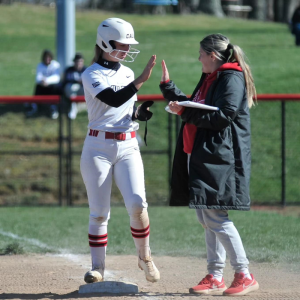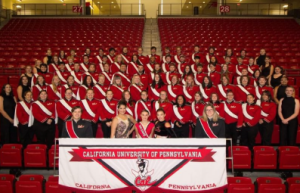Big Changes Discussed at Faculty Convocation
Enrollment, Department Merges talked about at Faculty Staff Convocation
February 5, 2016
At the Spring 2016 Faculty and Staff Convocation, Interim President Geraldine M. Jones called for optimism and support. President Jones acknowledged the tradition of New Year’s resolutions and the opportunity it provides to reflect on the past. President Jones reflected on her 44 months as President and the decisions she has made that affect thousands of livelihoods. She acknowledged that while there is still work to do there is a great story to be told.
The convocation began with Barbara Hess, the President of the California chapter for the Association of Pennsylvania State Colleges and University Faculties (APSCUF). Hess remarked that she has seen California University of Pennsylvania in lean and abundant times. But, dwindling funds and declining enrollment have made this a lean time for the university. The response from the faculty and staff, Hess said, must be perseverance. Despite the fact that Pennsylvania has yet to pass a budget and despite the fact that Pennsylvania’s State System of Higher Education is still flat funded, we all must persevere. Hess also acknowledges the harsh reality of these lean times: delayed maintenance restorations, fewer department resources, fewer scholarships for students, and most recently, two majors being placed in moratorium and faculty members being laid off. Hess concluded by asking the attendees to get on the bus to Harrisburg February 8th donned in Cal U apparel to advocate fair funding for state-owned universities.
President Jones followed Hess by addressing the fundamental question of the university, how to provide a high quality academic experience while also maintaining long term stability for California University of Pennsylvania. The primary answer to this questions lies in financial solvency. In order to achieve this, administration and faculty must address how to increase enrollment, increase revenue, and decrease spending. Jones first addressed the issue of enrollment, a key factor in planning. In recent years enrollment for the university has declined significantly, from 9,400 students to 7,854. Jones pointed out that tuition and fees account for two thirds of the universities revenue. In order to fix the problem, the university has brought in Ruffalo Noel Levitz to address enrollment management and enhance student searching. Already the university has seen progress; however, the full impact will not be felt until the 2017-2018 academic year.
In order to decrease spending, many difficult decisions have been made to calibrate with the declining enrollment and revenue. Course offerings have been reduced by 3%, positions have been left unfilled, positions have been outsourced, and the size of the staff has been reduced. Philosophy and Spanish majors have been placed in moratorium to free up resources for more highly demanded programs, Jones said. Academic departments have been reorganized and reduced from nine departments to seven, and Jones said her goal is to have six departments.
On a positive side, many practices have been implemented in order to increase revenue despite the declining enrollment. Such practices include continuing the Winter College program, which has seen a 9% increase in students. Jones noted the program is both efficient and cost effective. Other practices include the Finish Line program, a degree completion program that targets those that have left college without graduating to help them return and obtain a degree. Online military schooling for those serving in all military branches and international students have also contributed to increasing revenue for Cal U. Other recent actions that have helped to improve revenue include purchasing residence halls and reducing supplemental pay.
Jones concluded by stating that the university has seen good performance indicators. She said that while challenges still lie ahead, Cal U is on the right path and moving in the right direction. Jones concluded by asking those in the room to look around, “This room is filled with smart, caring people who are realistic and resourceful, courageous and creative, and together we can face our challenges find solutions and emerge stronger than ever.”






